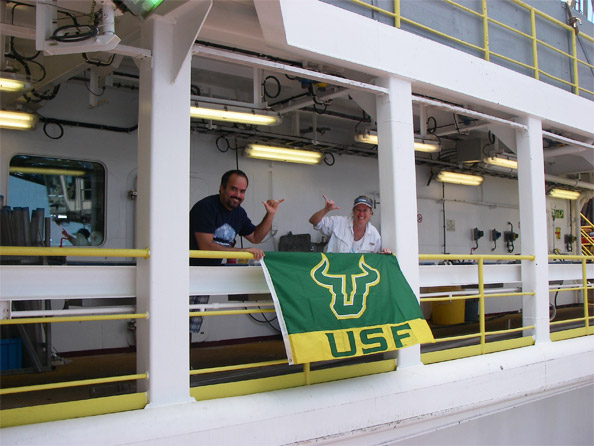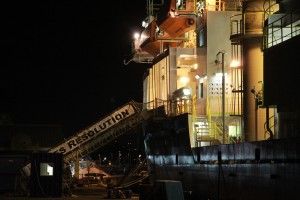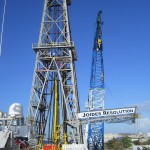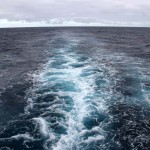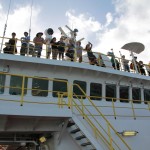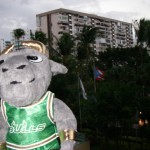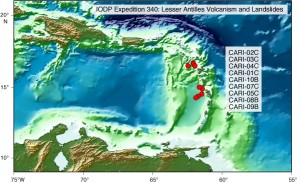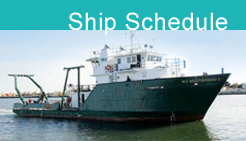Deep Sea Fish and Sediment Surveys in the Gulf
Oceanic Updates

Ship to Shore Broadcast
Mar 15th
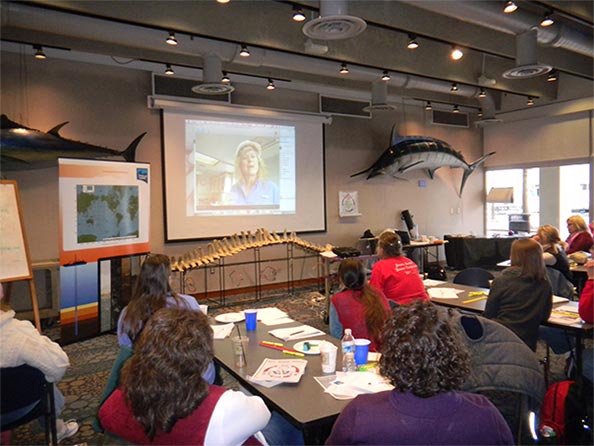
Teresa Greely connected with 30 teachers at the New England Aquarium via Skype. Greely was on the deck of the JOIDES Resolution, pointing out the volcano on Montserrat and explaining the science mission of Expedition 340. The teachers were part of a Deep Earth Academy professional development in New England.

Day 2 @ Sea, Educator’s Blog (March 6, traveled 190 nautical miles today)
Mar 13th
Meet the JOIDES Resolution
Enjoy this image of the JR at night. The JOIDES is a beautiful site day or night sunset or sunrise. The JR has traveled almost 500,000 miles, crossed the Equator; Arctic Circle, and Antarctic Circle several times, drilled in all the ocean basins and recovered over 155 miles of core. Only a vessel equipped like this one is capable of the research we soon begin our search for earth’s secrets in the Lesser Antilles.
Another point of interest about the JR is that it can drill down more than 2,000 meters into the seafloor and in waters as deep as 7,000 meters. Wow, 2000 meters into the earth’s crust.
A good night’s rest
We have been sailing through the night and awoke to beautiful deep blue water. There is nothing like sleeping aboard a vessel. Something about the humming engines and gentle rock to and fro that makes sleep deeper and more peaceful. Well, unless you do not yet have your sea legs!
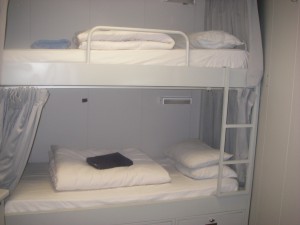
This is where we sleep aboard the JR. The living accommodations are called the Hotel. When below deck in our quarters we must keep the noise level to minimum because we work around the clock, so someone is always sleeping and someone is always working.
Sunset between Volcano Peaks
Day two of our travel in the late afternoon we had our first glimpse of the Lesser Antilles islands. We first passed Antigua and then continued south to Montserrat. What a spectacular volcano! We are at our first sampling location after traveling 347 nautical miles in about 33 hours. It is almost time for sunset so the entire volcano is not visible. The sun is setting on the west side of the island and the JOIDES Resolution is anchoring on the Eastern side. Here is a photo of the island as the JR stopped steaming in order to begin preparation of the sampling site for drilling.

Day 1 @ Sea, Educator’s Blog (March 5, traveled 157 nautical miles today)
Mar 13th
Bon Voyage! We have only just begun
Greeting ocean explorers! It is official: we are sailing. We left port from San Juan, Puerto Rico on March 5 and are en route to our first sampling location. It was a great feeling to hear the props turning, engines humming and tugboats assisting as we left the harbor. The entire science crew was on deck for the Bon Voyage, filled with excitement and anticipation of the earth’s mysteries that would be revealed during Expedition 340.
- This logo on the port and starboard side of the JOIDES Resolution says it all; we are beginning our journey as ocean detectives hoping to uncover the earth’s mysteries preserved in the ocean’s floor.
- Its official no going back, the gang plank has been hoisted we are now all aboard.
- This photo of the ship’s wake was taken from the stern of the JR as we set sail and had our last glance of land for 40 days.
- The Expedition 340 science party assembled on the main deck as we set sail for the Lesser Antilles.

Meet the chief scientists for our Expedition who have collectively written the script for this exploration through the proposal process. Because of their success we will soon attempt to retrieve our first glimpse of the seafloor around the islands of the Lesser Antilles at greater depths than before possible thanks to the technology and brawn of the JOIDES Resolution.
Safety First!

Photo of Teresa in safety gear with USF’s Rocky the Bull and Honors’ class mascot Mr. Flajelly the Penguin.
First task after we had sailed a few hours was to have our all hands Safety Drill. When the very loud bell rang, we all grabbed our life vests, eye goggles and hard hats. Sort of like ‘March of the Penguins’ we all climbed the stairs to the life boats to await our instructions. Joining me for the safety drill were two VIPs aboard the JR, USF’s very own mascot Rocky the Bull and another mascot Mr. Penguin from the USF Honors College students in my class this semester.

Arrival in San Juan, Puerto Rico
Mar 12th
Greetings ocean explorers! We arrived at the port of call where we will board the JOIDES Resolution, a 470 foot research vessel. This is a very, very large ship compared to most research ships. There is only one larger than the JOIDES Resolution. Can anyone name the largest research vessel?
Rocky the Bull and Mr. Penguin both arrived safely, too. Your mascots enjoyed the beautiful weather by visiting the beach and lounging at the pool for a bit in the morning before riding to where the JR was docked. Later, at the port we met up with Michael Martinez, a USF graduate student in the College of Marine Science, who will be studying microfossils (foraminifera or forams) that are retrieved from the core samples. Forams are a very important because the shells of these tiny protists are commonly preserved in marine sediments. Foram shells are buried as part of the ocean floor and as fossils can tell us something about the environment when they were living organisms (e.g. water depth). To dig deeper visit Michael’s advisor, Dr. Pamela Hallock-Muller’s lab.
- Rocky enjoying the view from the hotel in San Juan, Puerto Rico, Viva! Rocky liked the flag showing in this photo.
- Rocky enjoying a view of the beach in front of hotel… reminded him of home in Florida. But not homesick, too much excitement about going on this 40 day journey to the Lesser Antilles from a research vessel.
- Michael Martinez, a USF graduate student sailing aboard the JOIDES to study microfossils from the marine sediments we will collect as part of the cores retrieved from the ocean floor. Like Rocky and Mr. Penguin this is also Michael’s first time on the JOIDES Resolution.
The Adventure Begins!
Mar 2nd
Welcome fellow Ocean Explorers. Thanks for joining me on Research Expedition 340 to the Lesser Antilles. Your virtual research cruise sails from March 6, 2012 through April 17, 2012. The adventure will take place aboard the international ocean drilling ship, the JOIDES Resolution.
The purpose for this blog is to provide an authentic ‘Life at Sea’ experience for 40 days and 40 nights, so ask questions about living on a ship, food, recreation, etc. I invite you to follow along by visiting this blog, posting comments and questions, and touring the JR website, especially Expedition 340. So prepare your sea legs and off we go beginning March 6!
Each week test your best ocean sleuthing skills, as I ask the question “Where on the JR is Rocky the Bull?” Rocky will be a VIP aboard and will tour a different part of the vessel each week. You are invited to guess where Rocky is and determine what activities take place in the location Rocky is either videoed or photographed.
Our Science Mission
During the 40 days sailing aboard the JR it is our goal to retrieve 9 cores from the ocean floor (refer to the map to the right) in order to document the history and dynamics of three volcanic centers of the Lesser Antilles island arc. From these cores scientists will attempt to represent the full range of observed volcanic behavior. Read more as I blog the day to day activities aboard, both the science and life at sea. Remember to post your questions and comments.
Join the Expedition 340 scientists as we decipher volcanic processes along the island arc of the Lesser Antilles (also known as the Caribbees). The islands of the Lesser Antilles form the eastern boundary of the Caribbean Sea and Atlantic Ocean. The Caribbean islands are regions of intense seismic activity, including frequent earthquakes, occasional tsunamis and volcanic eruptions. The more we know about what controls volcanic processes the better we can understand their dynamics and the potential geohazards created by them.
Most of our understanding of these island volcanoes is from studies on land, which provides only part of the geologic record. But now during Expedition 340 we will explore the rest of the geologic story by recovering cores and marine deposits of volcanic debris from the ocean floor. By retrieving ocean-based cores that cover more than a million years of magmatic activity and sampling directly through volcanic avalanche deposits, additional pieces of the geology puzzle will be discovered. Then by combining the land and ocean-based geologic records a more complete volcanic story can be composed about island arc volcanism.
USF Honors Students
In addition to the Adventures at Sea blog, my students from the two Honors classes I am teaching will be joining me aboard the JR via video conferences in late March and early April. This is not the typical science class! Students will be blogging and tweeting during the 40 days and responding to weekly science challenge questions as well as tours of the JR vessel. The class mascots are a penguin, named Dr. FlaJelly, and a narwhale, named Unicorn of the Sea.

